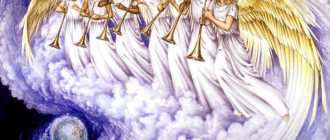Scientific articles by the author: Galactic years | Gold network | The rhythm of migrations | Geophysics of passionarity | Doublet gene code | Laws of orbits | Heavenly theonyms
Technological developments of the author (see): Replication of a distributed Oracle database | Category of network information | Web-based pipeline monitoring via SCADA
Alphabetical list of pages: | | | | | E (Yo) | | | | | | | | | | | | | | | | | | | | | | | | 0-9 | AZ (English)
Historical cycles in the Bible
Types of cycles
There are real 600-, 500- (and possibly 400-) year cycles. A full circle consists of 4 seasons of 7 * 600 = 4200 years, i.e., 16400 years. (or perhaps from 10*600=6000l, when all 3 cycles are combined)
General characteristics of the cycles:
- ? 300 - similar to 600 years old (A. Maked., Attila)
- ? 400 — (Adam, Voz.from Captivity)
- 500 - epoch-making events among the Jews and not only (Coming into Egypt, Exodus from Egypt, Return from Captivity, Crucifixion and the War of Judas, Fall. Rome, ?, Discovery of America (Fall. Maya, Azt., Inc. .) & Fall. Const. & Fall. Kazan, ECSR>IIWW>Obr.Israel)
- ? 700 - (Corr.Mira, 3500?, 2800?, V.Flood, Akhenaten and e/god. in Egypt, Found.Rome?, 0, Caliphate?, Timur?)
- 600 - prophets and leaders (Adam, ?, ?, Abram, Moses (& Zoroaster ?), Buddha & David, Christ, Muhammad, Genghis, Marx)
- ? 900 - key conquests/settlements of the Jews (Noah, Abram, Joshua)
Other assumptions:
- Apparently, in the Bible, time is counted sometimes in solar years, sometimes in lunar years, and sometimes, like the Romans - 280 days (10 lunar months each) or the Mayans - 260 days (20 13-days)
- Maybe Belovodye, where the prophets and sages are, is the Dead Sea?
- By the way, the Bible states that before there was no Dead Sea - this was Valley C...
The Bible also indicates cycles of 400-600 years (14*30=420, 14*35=490, 14*40=560):
- from Abram to David - 14 generations
- from David to the Babylonian Captivity - 14 generations
- from the Babylonian Captivity to Christ - 14 births
In more precise chronology:
- from Adam to Noah - 1000+56
- from Adam to Abram - 2000-54 => from Noah to Abram - 900-10
Historical events in cycles
| From RH | From RH | From RH | № | Event | from SM | |
| 400 | 500 | 3-600 | ||||
| 4500 | 4500? | 0. | ? | |||
| With | 4200? | 1. | world creation | 0 | ||
| 4000 | 2. | ? | ||||
| 3 | 3900 | 3. | Large settlement? | |||
| Ubaidians? | ||||||
| h D1 3379?3600? 3. Creation of Adam 264 (1242 before Noah) | ||||||
| 3500 4. ? | ||||||
| 3 3300? 5. ? | ||||||
| Sumerians | ||||||
| s - 3000 3000? 6. Expulsion from Paradise /A | ||||||
| 9c 3000 6. Arrival of the Sumerians in Mesopotamia | ||||||
| 9 3000 6. Settlement of Indo-Europeans throughout Europe | ||||||
| ===Akkadians? === | ||||||
| 3hD2 2700? 7. Birth. Nov 1506 | ||||||
| 2500 8. ? | ||||||
| 2400 9. ? | ||||||
| s — 2100?10! Great Flood /N 2106 (1506+600; 1&2) [1566?] | ||||||
| 3 2098 10. Settlement in Mesopotamia from the East | ||||||
| === ? === | ||||||
| h 2000? 11. Birth. Nimroda | ||||||
| s + - 11. Tower of Babel /N | ||||||
| since 1994? 11. Disintegration of m/nats. states, settlement of peoples | ||||||
| === ? === | ||||||
| h 1870?12. Birth Terah | ||||||
| === Chaldeans (Amorites) === | ||||||
| h D3 1800 12. Birth. Avram 2402 (2107&2+295) 2586? (1080+1506) 3186? (1080+2106) | ||||||
| from - 17..?12. Terah's Exodus from Ur/F | ||||||
| c - 12. Abram’s exodus from Haran /A | ||||||
| s + 12! War with Tutal "m/people." coalition in ch. with Abraham /A | ||||||
| === Jews,... === | ||||||
| Part 13. Birth of Isaac (Israel?) 2502 (2402+100) | ||||||
| ===Hyksos? === | ||||||
| h 1500 1500 13. Birth. Jacob 2562 (2502+60) [500l from VP] | ||||||
| c - 13. Arrival in Egypt /I | ||||||
| 1450 Earthquake on Crete. The end of the Cretan thalassocracy. | ||||||
| Migration of the Philistines (and Phoenicians?) | ||||||
| h 1400 14. Birth of Akhenaten | ||||||
| from 14. Monotheism in Egypt | ||||||
| ————————————————————— | ||||||
| h D4 1200 15. Birth. Moses 3101? (2586+515) | ||||||
| *************************************************************** | ||||||
| from 1250?15! Fall of Troy | ||||||
| 1200 15! Invasion of the "Sea Peoples", the collapse of Hittite | ||||||
| Europe conquers Asia (from Thrace to Egypt) | ||||||
| *************************************************************** | ||||||
| s + 1200 16. Exodus from Egypt /M (+430 [500l from birth] from the arrival of Jacob) | ||||||
| h 1200?17. Birth I.Navina | ||||||
| 3c+ 1150?17. Conquest of Canaan /IN | ||||||
| h 1010?18. Birth David 3671? (3101+570) 1350 fromRH? | ||||||
| s + 18. Education of Israel /D | ||||||
| h 980?19. Birth Solomon | ||||||
| from +940?19. First Temple /S (p-li for 480 [500l] village Ex, for 4 rights) | ||||||
| 7 754 20. Founding of Rome | ||||||
| s - 587?21. Rez.Temple, Vav.Plén | ||||||
| ————————————————————— | ||||||
| ch 558 22. Birth of Cyrus (558-529); great humanitarian goal | ||||||
| from 22. Persian Empire (553-Mid,550-vl,546-Ind,Lid,MA,538-Vav) | ||||||
| с + 538 22. Return from Captivity | ||||||
| 3 310?23. Birth of A. Macedonian (rights 336-323); great cultural purpose; | ||||||
| Europe conquers Asia (from Thrace to Egypt) | ||||||
| p 23. Collapse of Persia; spread of Hellenism | ||||||
| h D5 0 0 24. Birth of Christ (at 490 [500l] after the construction of the Temple) | ||||||
| chs- 33 33 24. Crucifixion of Christ | ||||||
| =============================================================== | ||||||
| ~450 25. Attila (right 433-453); | ||||||
| Asia conquers Europe (from Mongolia to Italy) (451-Cat.sr.) | ||||||
| Part 26. Birth? | ||||||
| c - 476 26. Fall of Rome (after the emperor, the leader Odoacer) | ||||||
| ch 600 27. Birth of Mohammed | ||||||
| s + 27. Acceptance of Islam /M (621 fromRH); Exodus from Mecca (622) | ||||||
| c + 27. Creation of the Caliphate /? | ||||||
| h 900?28. Birth of Svyatoslav | ||||||
| s - 900?28. Fall of Khazaria | ||||||
| Part 29. Birth of Vladimir | ||||||
| s + 1000 29. Baptism of Rus' | ||||||
| ch 1155 30. Birth of Genghis Khan (1155-1227) | ||||||
| *************************************************************** | ||||||
| from 1200 30! Invasion of the Tatar-Mongols, the collapse of China, the death of cities | ||||||
| Asia conquers Europe (from Mongolia to Italy) (1223-Kalka) | ||||||
| *************************************************************** | ||||||
| p - 31. Conquest of Rus' /B | ||||||
| 1453 Fall of Constantinople | ||||||
| h 1500 32. Birth of Columbus | ||||||
| with +? 1500 32. Discovery of America /K,A? | ||||||
| With -? 1500 32. Fall of Byzantium | ||||||
| with +? 1500 32. Fall of Kazan | ||||||
| ————————————————————— | ||||||
=== 1800-2000 - birth of great people: Marx, Bakunin, ===
=== Lenin, Trotsky, Stalin, Hitler, C. Guevara, Fidel, ===
=== Saddam, Gaddafi, Roosevelt, Mao, Ford, A. Einstein, ===
=== and other politicians, scientists, industrialists, culture ===
h 1800 30. Birth of Marx
from 1812 30! War with Napoleon m/people. coalitions in ch. with Russia
from - 1917 30. October Revolution /L
Russian Folk Calendar
What was the situation with chronology in the not so distant past - in our era? Starting from baptism in the 10th century according to the Gregorian calendar we are used to?
In Rus', the calendar was called a monthly calendar. This is an agricultural or folk calendar. Along with it, church and civil existed and were used. All three calendars were similar in some ways, but very different in others. Therefore, confusion arose quite often. The folk calendar indicated events related to the life of peasants - when to carry out certain work. This is a kind of encyclopedia of folk life - a diary of everyday life and holidays, customs and culture of that time.
After the adoption of Christianity, many folk holidays became banned by the church as pagan. The people could not so easily abandon their customs and rituals, so the church skillfully replaced the names of holidays, renamed saints and changed the interpretation to Christian.
At the baptism of Rus', the Julian calendar was introduced. It was not accepted by the people because the names of the months were incomprehensible - the numbers are in Latin, there are 3 more months themselves, and the beginning of the year is in the fall, not in the spring. The clergy came up with a way out - they began to call the months in Slavic: stuzhen, serpen, etc. Then the names of the months took root, but the folk calendar continued to be used along with the church calendar. After all, in the church it was possible to look only at church dates, but in life completely different ones were required - when to carry out this or that work, when to celebrate the day of Kupala or Maslenitsa-Maryon.
In addition, there was confusion with the coverage of events. Russian chroniclers pointed to a date from S.M.Z.H. taking into account that the beginning of the year was in the spring. Greek invited chroniclers - date from S.M. from the beginning of the year in the fall. There was a difference of 1 year if the date fell, for example, on March 1. Ivan the Third issued a Decree according to which the beginning of the year began to be celebrated from March 1, 6856 from S.M.Z.H. The people responded to the ban on using the “old” calendar with riots and reprisals against “God’s” people. Ivan the Third was forced to allow the use of two calendars. One - church - was considered official, and the second - folk.
By the summer of 7000, “doomsday” sentiments began. After the date arrived, making sure that the apocalypse had not occurred, the Church decided to move the beginning of the year from March 1 to September 1.
In 7090, the Catholic Church adopted the calendar of Pope Gregory XII. We call it Gregorian. And the calculation according to the Gregorian calendar began to be carried out from the Nativity of Christ.
It is further known that Peter I introduced the Gregorian calendar in 7208 and became the year 1700 on January 1.
Whenever possible, pagan holidays were “reshaped” into Christian ones: the Day of God Veles became the day of Blasius. The Day of God Kupala is the day of John the Baptist. The Day of God Perun is the day of Elijah the Prophet.
Gradually, the folk calendar became twofold - folk customs, pagan and Christian holidays were intertwined in it.
Folk calculus, be that as it may, is firmly connected with the change of seasons. Spiridon's Day is the day of the winter solstice (December 21) and it was moved to the 25th - Christmas. And Maslenitsa - the beginning of the cycle (of the year in modern terms) - from March 21 according to the Christian calendar is timed to coincide with Easter and began to have a floating date.
As a result, we have a kind of fusion of Orthodoxy and Christianity in the calendar. The coexistence of folk and church dates and holidays is now impossible to separate in any way; it is a whole system. Alive, changing and developing. The national calendar depends on the situation in the country, reflecting and incorporating all that is most important and significant.
Historical layers in the Bible
The Bible was composed by various peoples:
- Genesis (1 book of Moses):
- from the Creation of the world to the Flood (from Adam to Noah) - by the pre-Sumerians (Ubadians?), then borrowed by the Jews through the Sumerians and Chaldeans
- from the Flood to Terah - by the Sumerians and Chaldeans
- from Abraham to Moses - the ancestors of the Arabs and Jews
- Exodus (2 books of Moses) - under the leadership of Moses or after him (David?):
- from Moses to David - “Israelites” (core - Sea Peoples, Moses - Armenian (Moscow))
- from David to Christ - Jews
- Leviticus (3 books of Moses) - by Moses himself, or under his leadership
The chronology in the Sumerian Scriptures was based on their system (6-10-60-600-3600...) and when rewritten by Jewish scribes it could be distorted (10-100-1000...)
Why is it difficult to restore the Slavic calendar?
Have you also noticed that if you multiply 40 days by 9 months, we get 360 days, which is not 365? Where did 5-6 days a year go, if historians claim that the Slavic chronology was so accurate that even over several millennia no errors accumulated, and not like we have leap years every four years? The fact is that there could be 40 or 41 days in the fortieth period.
There were 16 hours in a day with 144 parts. 1 hour (approximately 90 minutes) was 1296 Beats (approximately 37.56 seconds). In the Valley there are 72 moments, each moment is 760 moments. One Mig was equal to 160 Sigs, and a Sig was equal to 14 thousand Santigs.
1 second = 34.5 beats = 2484.34 Moments = 1888102.236 Moments = 302096358 Moments
Another question is how and who finds and explains sources. Scientists are people too. In 1988, the oldest human site was discovered in the Diring-Yuryakh area. This is Yakutia. The estimated age of the site is about 2.5 million years. But according to the generally accepted theory, life began to spread from Africa. (Not to mention from a monkey). A settlement dating from the 20th century - 2 BC was found in the Chelyabinsk region. - Arkaim. Excavations prove that man at that time was very culturally developed, again, not to mention other aspects of development. The debates between historians and the labeling of “pseudo-scientists” and “esotericists” do not stop. The very spread of dating of the buildings of Arkaim is indicative - from the 20th to the 2nd century BC.
The Achinsk rod (calendar) is about 18 thousand years old. The same questions without answers.
It turns out that it is not enough to find a “trace”, it is also necessary to interpret it.
Legends reach us not only through stones and settlements. Another direction is oral folk art. This is where your imagination can run wild! As they say, there is no smoke without fire. If some important event occurred, it will definitely be reflected. The tale of that important event, growing in detail, will be passed on from generation to generation. And through fairy tales, where “lies are a lesson for good fellows,” you can catch the thread of knowledge accumulated a long, long time ago.
But this is a completely different story... As a result of creativity, one can give an example of a palace by date of birth or a Slavic totem calendar.
Biblical reason for historical events
Causes and effects:
- The Persian Empire (Cyrus) was necessary to liberate Jerusalem
- A. Macedonian was necessary for the Hellenization of the East for the subsequent spread of Christianity, and died untimely because he tried to make Babylon the capital of his empire, but Babylon was doomed by God to destruction due to the destruction of Jerusalem
- Rome arose in 753. like the new Judea, captured at this time by Assyria
Igor Garshin, E-mail: [email protected] , URL: . Up: Mythology
As an advertisement (see terms and conditions): skillbox online programming courses. . Find out the latest news from the country and the world on the portal inforakurs.com. Find out interesting world news at https://gazetainfo.com/. In a convenient format.
And a little about the chronology of space (the world as a whole)
According to science, the age of the Universe is determined to be 12-15 billion years. But even here the birthmark of historical reminiscences is manifested quite clearly. And here, as in all historical sciences, the basis is based on postulates about the invariance of some processes over time. For example, in cosmology, the time of the “Big Bang”, i.e. the beginning of the formation of our entire world was determined by the speeds at which galaxies recede. Cosmologists simply took and virtually spun all visible galaxies back in time, and calculated that such and such a time ago they should all have been at one point.
Well, okay, the current speeds of galaxies are determined, say, quite provably by the so-called “red shift” in their spectrum (Doppler effect), although there may be questions here - certain postulates are also involved here. But the very first thing that is immediately visible is: who said that these run-up speeds have always been like this? It is enough to accept that they are actively slowing down over time, as if they are slowing down (i.e. that their speeds used to be much higher), and then the time figure for the formation of the world will decrease significantly - the beginning of the world will approach our moment in time. Indeed, then, depending on the deceleration we have adopted (which is no worse than the accepted constancy of speeds), the duration of the formation of the world will be reduced to at least millions of years, at least to thousands, i.e. may become quite comparable to the Torah, or even simply equal to the age indicated in it.
In general, everything here is similar to problems with the age of the Earth. Only it might be even clearer, because... Instead of the abstract and perhaps difficult to understand "half-life constant", the simple velocities of astronomical objects appear here.





